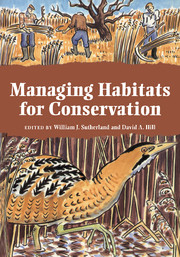Book contents
- Frontmatter
- Contents
- List of Contributors
- Acknowledgements
- 1 Introduction and principles of ecological management
- 2 Site management planning
- 3 Access
- 4 Coastal habitats
- 5 Rivers, canals and dykes
- 6 Waterbodies
- 7 Reedbeds, fens and acid bogs
- 8 Grasslands
- 9 Farmland
- 10 Lowland heathland
- 11 Upland moors and heaths
- 12 Woodland and scrub
- 13 Urban areas
- Some useful addresses
- Index of species by common names
- Subject index
4 - Coastal habitats
Published online by Cambridge University Press: 05 February 2015
- Frontmatter
- Contents
- List of Contributors
- Acknowledgements
- 1 Introduction and principles of ecological management
- 2 Site management planning
- 3 Access
- 4 Coastal habitats
- 5 Rivers, canals and dykes
- 6 Waterbodies
- 7 Reedbeds, fens and acid bogs
- 8 Grasslands
- 9 Farmland
- 10 Lowland heathland
- 11 Upland moors and heaths
- 12 Woodland and scrub
- 13 Urban areas
- Some useful addresses
- Index of species by common names
- Subject index
Summary
Introduction
This chapter encompasses a range of habitats including the open sea, rocky shores, shingle, estuaries, sea cliffs, dunes and saltmarshes. There are 19 336km of coastline in the UK. Within mainland Britain, the coastal habitats contain many of the most important areas for conservation and are of international importance. For many of these habitats, the opportunities for management may be restricted. Coastal areas are popular for a wide range of human activities including sailing, fishing, shooting, diving, and the study of natural history, such that minimising the conflict between access and conservation is one of the major issues.
Land ownership may be complex. Legislation, conventions and site declarations vary in the extent to which they cover the intertidal area. Below the low water mark the seabed in UK territorial waters is the responsibility of the Crown Estate Commissioners, while passage through the overlying sea for the purpose of peaceful navigation is guaranteed by international convention. Many organisations and international conventions operate in coastal waters, including estuaries and intertidal areas.
The manager of a coastal habitat which includes any area below the high water mark is immediately faced with a range of legal and traditional rights to take into account in the management plan. Voluntary marine nature reserves can work, in spite of the wide range of organisations with jurisdiction or interest in the coastal zone, but their establishment can be an extremely slow process (Gubbay, 1986).
- Type
- Chapter
- Information
- Managing Habitats for Conservation , pp. 59 - 83Publisher: Cambridge University PressPrint publication year: 1995
- 2
- Cited by

